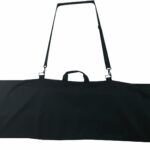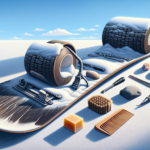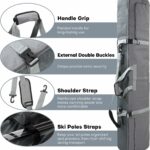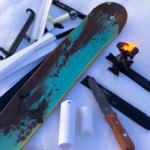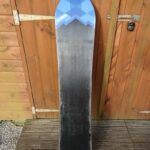Gliding down snowy slopes on your trusty snowboard can be a thrilling experience, until you find yourself face-to-face with damaged equipment that can potentially ruin your adventure. This article is your handy guide on how to fix your snowboard. From minor scratches and dents to more serious damage, you’ll learn everything you need to get your board back in shape, ready to slice through that fresh powder again.
Understanding the Basics of Snowboard Maintenance
Just like any other athletic gear, your snowboard requires a bit of tender loving care. Regular maintenance not only ensures that your snowboard performs well on the slopes but also increases its lifespan.
Identifying Common problems with Snowboards
Snowboarding is an extreme sport, much hard on gear. Some of the common problems you’ll face with your snowboard include scratches and gouges on the base, damage to the edges, and issues with the bindings, such as loose screws. You might also notice strains on the topsheet or wax wearing out.
Knowing When to DIY and When to Get Professional Help
While you can fix minor problems such as small scratches, waxing, edge tuning, and loose bindings at home, major damages like deep gouges, severely damaged edges, and broken bindings may require professional help. Knowing the extent of the problem will guide you in making the right decision.
Gathering Essential Tools for Snowboard Repair
You’ll need a few basic tools for snowboard maintenance. A metal scraper, plastic scraper, iron, P-Tex, file or edge tuner, screwdriver, specialized snowboard cleaner, and wax are typically vital.
Assessing the Damage
Before you get into the repair process, evaluate the extent of the damage. This helps you know what tools you’ll need and whether the damage is something you can fix yourself or if you need to seek professional help.
Evaluating the Base Damage
Examine the bottom of your snowboard. Look for scratches and scuffs that may affect your performance on the slope. Deeper gouges are more serious and may require filling with materials like P-Tex.
Checking the Edges for Issues
The edges of your snowboard are crucial for control during your ride. Inspect them for any nicks, dents, or rust, as these could adversely affect your performance.
Inspecting the Bindings
Bindings keep your feet securely attached to the board and any issues can be safety hazards. Look for any loose screws or bolts, damaged or worn parts.
Cleaning the Snowboard
Regular cleaning is part of keeping your snowboard in top shape. Always clean your board after a day on the slopes to get rid of dirt and grime that may accelerate wear and tear.
Wiping Down the Surface
Use a specialized snowboard cleaner to wipe down the surface gently. This removes dirt and dust and preps the surface for further treatment.
Cleaning Dust and Grime from Bindings
Dirt and grime on bindings can lead to issues over time. Use a soft brush to clean off any dust or dirt, paying special attention to the small crevices.
Removing Old Wax
Get rid of old wax using a plastic scraper. This helps to remove any dust or dirt trapped in the wax, giving a fresh start for the new wax application.
Repairing Base Damage
With frequent uses, the base of your snowboard is prone to damage. Here’s what you need to know.
Addressing Minor Scratches and Scuffs
Minor scratches and scuffs don’t usually require extensive repair. Simply clean the area and add a layer of wax to smoothen out the base.
Fixing Deeper Gouges
Deeper gouges or cuts can significantly affect the board’s performance. Fill these with P-Tex. Remember to clean the base appropriately before applying.
Using P-Tex to Fill in Damage
P-Tex is a material used to fill in gouges on the base of your snowboard. The material fills the gaps, which hardens to form a smooth surface.
Fixing Snowboard Edges
Keeping your edges in peak condition is vital for control and turns when snowboarding.
Filing Down Minor Nicks and Dents
Filing can fix minor nicks and dents on your snowboard’s edges. Using an edge tuner or a file, follow the original edge shape while correcting the irregularities.
Addressing Major Edge Damage
Major edge damage may require professional help. But, if it is minor, you can use an epoxy adhesive for repair. Remember to smooth out with a file before it fully dries.
Taking Care of Rusty Edges
Rusty edges can diminish your control over the board. Use an edge tuner accompanied by some elbow grease to scrape off the rust.
Treating Damage to the Snowboard Top
Scratches and strains may affect the aesthetic appeal of your board but usually don’t affect its performance.
Dealing with Scratches and Marks
Use a specialized snowboard cleaner to remove unsightly scratches and marks. For minor scratches, a layer of wax does the trick!
Fixing Delaminations
Delamination refers to the separation of the board’s layers. Repair delamination with a special epoxy adhesive for snowboards.
Addressing Major Top Sheet Damage
Major damage to the board’s top sheet may necessitate professional help. However, if manageable, fix it with epoxy and clamps to hold it together as it dries.
Repairing or Replacing Bindings
Bindings are critical for secure footing and control. Repairs or replacements are necessary when you notice significant issues.
Assessing Damage to Bindings
Regularly check your bindings for excessive wear or damage. Loose screws or fraying straps require immediate attention.
Tightening Loose Screws and Bolts
Do frequent checks to confirm all screws and bolts are tight. Loose hardware can unexpectedly disengage, posing great risk during rides.
Replacing Broken Bindings
In case of irreparable damage or broken parts, replacement of the bindings would be the best course of action. Be sure to choose quality bindings and have them fitted professionally.
Waxing a Snowboard
Regular waxing of your board not only enhances performance but also offers a protective layer against rust and damage.
Choosing the Right Wax
There are different waxes for different conditions. Temperature plays a key role in wax selection. Always read the wax packaging to select the appropriate one for your ride.
Applying Hot Wax
Use an iron to melt the wax and apply it evenly on the base of your board. The wax helps to smooth out the base, offering smoother rides.
Scraping and Buffing the Wax
After applying, use a plastic scraper to remove excess wax. Then, use a brush or a buffing tool to finish off.
Edge Tuning
Edge tuning is a critical part of snowboard maintenance for peak performance.
Figuring Out the Right Edge Angle
Your riding style and snow conditions influence the right edge angle. The standard is usually between 87 to 90 degrees. The more aggressive the angle, the sharper the turns.
Using an Edge Tuner
An edge tuner helps you maintain the desired edge angle. Run it along the edge, ensuring to maintain the angle for uniformity.
Taking Care of Burrs
Burrs are rough spots on your edges that can disrupt your ride. File them away with a diamond stone for smooth gliding.
Regular Maintenance for Longevity
Taking good care of your snowboard increases its lifespan. Clean regularly, check for damage, and store correctly.
Keeping the Snowboard Clean
Regular cleaning prevents build-up of dirt and grime, which can wear down the board. Always wipe your board down after use.
Regularly Checking for Damages
Frequent checks help in identifying and addressing damages early. This helps in preventing minor issues from turning into major ones.
Storing the Snowboard Properly
Proper storage involves drying off the snowboard and storing it in a cool, dry place. Be sure to add a good layer of wax on the base before storage to protect the surface.
In conclusion, understanding the basics of snowboard maintenance can significantly extend its lifespan while ensuring your safety and performance on the slopes. Remember to regularly inspect, clean, repair, and wax your snowboard. Also, do not hesitate to seek professional help when dealing with major damages.
- What Snowboard Bindings Should I Get? - January 23, 2024
- What Size Screws For Snowboard Bindings? - January 23, 2024
- How To Snowmobile On Water? - January 23, 2024


